
|
TOP STORIES |
|
For more about faculty research and other items, see Faculty News.
CELEBRATING OUR ANNIVERSARY WITH A DYNAMIC SPEAKER "What if we thought of academic medicine as a fully loaded Boeing 747, taking off down an undetermined length of runway? Are we so focused on preserving the excellence we have built, that we find ourselves waiting until the last possible moment to lift off into what will be a dramatically changed health care future? And by lingering on the runway, are we missing opportunities that might allow us to use our unique capacity to lead?"
Those are the attention-getting words of Darrell G. Kirch,
in
People who have little patience with most public speakers say without hesitation that Kirch is dynamic and memorable. Anyone who is connected with the College of Medicine will want to hear what he has to say about this time in history, this profession and this school.
We hope to pack the auditorium that night. Arrangements also are being made for people at our regional campuses to tune in his speech from their location.
Also on the Oct. 7 program is the premiere of a 20-minute video charting the extraordinary creation of the College of Medicine. This will be an unforgettable way to wrap up our 10-year anniversary. Please plan to participate.
Date: Thursday, Oct. 7 Time: 6-8 p.m. Place: College of Medicine main campus, 1115 W. Call St. in Tallahassee RSVP or questions: 850-645-9428 or alexa.vonstaden@med.fsu.edu Deadline to RSVP: Sept. 17 For more information about Kirch: Check his bio
AT LAST, FULL ENROLLMENT Ten years after its creation, the College of Medicine has reached a milestone: The June arrival of the 120-member Class of 2014 gave the medical school a full enrollment of 480 students.
In 2000, in the bill establishing the College of Medicine, the Florida Legislature outlined its plans for enrollment growth. The plans called for a yearly increase from an initial class of 30 students in 2001 to a maximum of 120. The first full class was admitted in 2007. With the last of its smaller classes graduating with medical degrees May 15, the college is now at full enrollment. To date, it has graduated six classes and has 336 alumni.
A glimpse of the newest class: o It has more male than female students (59 vs. 41 percent). Males hadn’t dominated since the Class of 2005. o Twenty-six percent of the class is from backgrounds that are underrepresented in medicine, including 20 Hispanic and nine black students. o The enrollment of Hispanic students is nearly triple the national average for U.S. medical schools.
SPEAKING OF STUDENT DIVERSITY…
A diverse
student population doesn’t just happen. It’s the result of deliberate work
that
The students, including Uchenna Ikediobi (in the center of the photo above) and Jimmy Moss (below), were part of a graduating class that included 12 African-Americans (13 percent of the class). In Florida, fewer than 5 percent of practicing physicians are African-American, while African-Americans make up 14 percent of the population. Overall, 19 percent of the Class of 2010 was from a background considered to be underrepresented in medicine.
The major components of the college’s outreach effort are SSTRIDE and the Bridge program. SSTRIDE (Science Students Together Reaching Instructional Diversity and Excellence) provides continuing academic support and assistance to students from seventh grade through college. It seeks to increase the number of underrepresented students, such as minority and rural students, in medical school and other science fields. The Bridge program provides a bridge into medical school for students whose characteristics make them good candidates for practicing primary care with underserved or minority patients in rural or inner-city communities. Those who successfully complete the rigorous three-semester Bridge Program are invited to join the next year’s class of first-year medical students. (Read about the SSTRIDE Summer Institute and the new master’s program for Bridge students below.)
“I immersed myself in all that SSTRIDE had to offer,” Moss said. “From becoming the vice president of its undergraduate organization, the Multicultural Association of Pre-health Students (MAPS), to taking part in its numerous outreach opportunities, I have truly become a part of the SSTRIDE family. The benefit of having an emotional and structural support system during my transition from nontraditional undergraduate to nontraditional medical student is indescribable.” (Find out more about SSTRIDE and Bridge.)
SUMMER PREVIEW OF MEDICAL SCHOOL One way in which SSTRIDE gives young students a taste of medical school is to invite them to its Summer Institute. This year, 54 students from across Florida participated in one of the three sessions. The college’s six regional campuses – in Daytona Beach, Fort Pierce, Orlando, Pensacola, Sarasota and Tallahassee – as well as the rural training site in Immokalee invited students from their area high schools to apply.
Elizabeth Foster, the college’s assistant director of research and graduate programs, traveled around the state in the spring to meet with students interested in medicine and in the Summer Institute. “The selection process is competitive,” she said. “We sought the best and brightest at their schools – from a GPA of at least 3.5 and outstanding leadership, volunteerism and a passion for science and medicine. They should feel proud about being selected. We’re certainly proud to have them here.” (Pictured: Samuel Ichite of Rickards High)
A SALUTE TO OUR NEWEST GRADS
Ninety-four more students have joined the
“You are our best ambassadors for this distributed model of education, based in the offices of community physicians,” Dean John Fogarty told the graduates, who since then have headed out to residencies that will last several years. Dean Emeritus Ocie Harris, chosen by the graduates to be commencement speaker, said his wish was for them to have “a love affair with medicine for the rest of your life.”
FIRST BRIDGE STUDENTS RECEIVE MASTER’S DEGREE
Ten members of the Class of 2014 arrived with
something that no one had ever had
FAMILIAR FACES GRADUATE FROM SACRED HEART Drs. Paul Payne and Chris Sundstrom are the first two College of Medicine alumni who have gone on to graduate from one of the college’s residency programs at Sacred Heart Women’s Hospital in Pensacola. They received their diplomas June 25 from Sacred Heart’s Department of Obstetrics and Gynecology. Sundstrom had been administrative chief resident. Payne received the overall award for best resident research.
Payne will be working at a private, multispecialty practice in Albany, Ga. Sundstrom is returning to Tallahassee to practice at the North Florida Women’s Care office at Tallahassee Memorial Hospital. The medical group has close ties to the college: 10 of its 13 health-care professionals are members of the Tallahassee regional campus’s clerkship faculty.
“NFWC has established itself as a practice of the highest quality in women's health care and has become a leader in community-based medical education,” Sundstrom said. “It’s a privilege to join their ranks. I am also very excited at the prospect of returning to Tallahassee.”
The College of Medicine sponsors the Sacred Heart Hospital programs, one for OB-GYN and one for pediatrics. (Photo, from left: Senior Associate Dean Alma Littles, Payne, Sundstrom, Pensacola Campus Dean Paul McLeod)
BETTER THAN A LIVING WILL Advance directives and living wills often don’t ensure that dying patients receive the medical care they want. Now an effort being coordinated by the Center for Innovative Collaboration in Medicine & Law hopes to improve communication and produce a clear set of medical orders for a dying patient’s care.
Tim Megraw has identified the important role that a key protein plays in cell division, a discovery that could lead to a greater understanding of stem cells. Megraw, Ph.D., an associate professor in Biomedical Sciences, outlined his findings in the June 15 issue of Developmental Cell. The article, “CDK5RAP2 Regulates Centriole Engagement and Cohesion in Mice,” was co-authored by researchers from the University of Texas Southwestern Medical Center at Dallas and the University of North Texas.
The centrioles are supposed to replicate only once during the cell cycle. What keeps them from replicating more often was discovered a few years ago, Megraw said, when researchers identified mother-daughter engagement as the key. Once those two become disengaged, it acts as the licensing step, in effect giving the centrioles permission to replicate. Unknown until now, Megraw said, was what regulated those centrioles to remain engaged until the proper time, to prevent excess replication. He suspected that the protein CDK5RAP2 was at least partly responsible. His team tested the protein’s role using a mutant mouse in which the protein was knocked out and not functioning. These researchers looked for any effects on engagement and cohesion, in which centriole pairs are tethered by fibers.
They noted in the mutant mouse that engagement and cohesion did not occur in their typical orderly fashion and that centrioles were more numerous and often single rather than paired. The amplified centrioles assembled multipolar spindles, a potential hazard for chromosomal stability. The researchers concluded that CDK5RAP2 is required to maintain centriole engagement and cohesion, thereby restricting centriole replication.
“The two mouse mutants we made mimic the two known mutations in humans in CDK5RAP2 — which has another name, MCPH3, in humans,” Megraw said. “The disease associated with that is a small brain. Our next step is to look at the brains of the mice and try to determine what’s wrong. We think it’s the stem cells — that the progenitors that give rise to all the neurons in the brain are dying early or changing from a progenitor into a neuron too early.”
KATO’S DISCOVERY MAY EXPLAIN HOW SOME CANCERS DEVELOP Yoichi Kato has discovered a new interaction between a cell signaling system and a specific gene that may be the cause of B-cell lymphoma. The finding suggests a similar interaction could be occurring during the development of other types of cancer, leading to further understanding of how cancer works — and how it might be stopped.
“There are very few molecules that we know directly inhibit Notch signaling,” Kato said. “So that is why the interaction, and our finding, is very interesting to people in many areas — cancer specialists, neuroscientists and many others.”
Kato’s team produced a paper outlining the findings that was published in the journal Developmental Cell, and Kato recently presented the paper at an international conference in Cold Spring Harbor, N.Y., for scientists studying early development of vertebrates. He and his researchers have focused on the Notch signaling pathway’s role in vertebrate early development. In their study, they found that when BCL6 inhibits the Notch signaling pathway during the early stages of embryo development, the alignment of the embryo’s internal organs is affected, which can lead to a congenital disorder. However, the Notch signaling pathway, which creates the equivalent of a molecular highway across a cell’s membrane, is involved in many types of cell-to-cell interaction, including neuron development, stem cell differentiation and apoptosis (programmed cell death).
The fact that BCL6 regulates the Notch signaling pathway could be important for any cellular process where Notch plays a role, including the formation of many cancers. BCL6 is a gene that, when mutated in certain ways, can lead to several types of B-cell lymphoma. B-cell lymphomas, including both Hodgkin’s and non-Hodgkin’s lymphomas, occur when B-cells, which produce antibodies to fight infections, mutate and become cancerous.
With more study of the interaction between the Notch signaling pathway and the BCL6 gene, scientists may be able to better understand how these cancers form. Kato and his lab plan to further investigate the interaction’s role in neural development, as well as how the interaction could affect stem cell formation.
Kato’s research is supported by grants from the National Institute of Child Health and Human Development and the Bankhead-Coley Cancer Research Program. |
 |
 |
 |
| E-mail Alumni Affairs Phone: 850-645-9428 | ||
|
|
|
Florida State University
|
College of Medicine
|
Copyright 2013
|

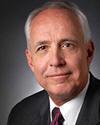 the July issue of the AAMC Reporter. As president and CEO of the
Association of American Medical Colleges, he spends an extraordinary amount
of time pondering the future of medical education and health care in
America. On the AAMC website you'll see photos of Kirch speaking with
President Barack Obama and the U.S. surgeon general, among others. Soon,
he'll be here. He has accepted our invitation to be keynote speaker at the
Oct. 7 celebration of our 10th anniversary as the first new medical school
of the 21st century.
the July issue of the AAMC Reporter. As president and CEO of the
Association of American Medical Colleges, he spends an extraordinary amount
of time pondering the future of medical education and health care in
America. On the AAMC website you'll see photos of Kirch speaking with
President Barack Obama and the U.S. surgeon general, among others. Soon,
he'll be here. He has accepted our invitation to be keynote speaker at the
Oct. 7 celebration of our 10th anniversary as the first new medical school
of the 21st century.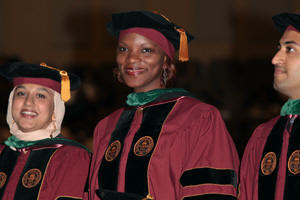
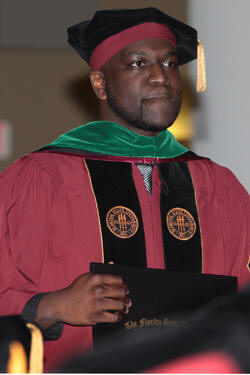 Class
of 2010 graduate Ikediobi became a SSTRIDE participant as a ninth-grader at
Rickards High School in Tallahassee. She also served as a mentor in the
program. Moss, whose family was temporarily homeless when he
was young and who overcame many obstacles before earning his M.D., credits
the College of Medicine’s outreach program with encouraging him to even
consider medical school.
Class
of 2010 graduate Ikediobi became a SSTRIDE participant as a ninth-grader at
Rickards High School in Tallahassee. She also served as a mentor in the
program. Moss, whose family was temporarily homeless when he
was young and who overcame many obstacles before earning his M.D., credits
the College of Medicine’s outreach program with encouraging him to even
consider medical school. 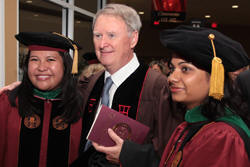
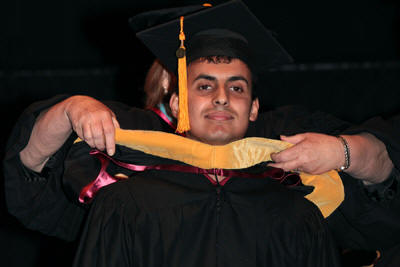 until
now: a master’s degree from the College of Medicine. They were the 10
members of the 2009-2010 Bridge Program. At the May 15 commencement program,
they each received a diploma signifying that they had earned a brand-new
degree: Master of Science in Biomedical Sciences, Bridge to Clinical
Medicine Major. The 10 students were Mohammed Al-Humiari (pictured
at left); Alrick Drummond; Geden Franck; Angela Green;
Lorenzo Hernandez; Miranda Mack; Melissa McDole;
Stephanie Morales; Colin Swigler; and Brett Thomas.
until
now: a master’s degree from the College of Medicine. They were the 10
members of the 2009-2010 Bridge Program. At the May 15 commencement program,
they each received a diploma signifying that they had earned a brand-new
degree: Master of Science in Biomedical Sciences, Bridge to Clinical
Medicine Major. The 10 students were Mohammed Al-Humiari (pictured
at left); Alrick Drummond; Geden Franck; Angela Green;
Lorenzo Hernandez; Miranda Mack; Melissa McDole;
Stephanie Morales; Colin Swigler; and Brett Thomas.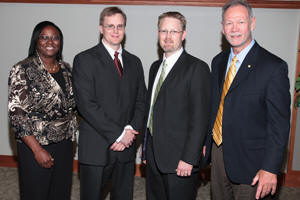 Both
are graduates of the College of Medicine's Class of 2006. Payne also
completed a year of the Bridge program. “Having the
trust of a patient is truly a great responsibility,” he said, “and I think FSU trained
me well in that respect.”
Both
are graduates of the College of Medicine's Class of 2006. Payne also
completed a year of the Bridge program. “Having the
trust of a patient is truly a great responsibility,” he said, “and I think FSU trained
me well in that respect.”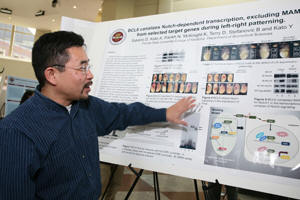 Kato,
Ph.D., an assistant professor in the Department of Biomedical Sciences, and
his lab team found that the gene – known in scientific shorthand as BCL6 –
can inhibit one of the pathways cells use to transmit signals to other
cells. Called the Notch signaling pathway, it’s an important mechanism for
cells to control gene regulation.
Kato,
Ph.D., an assistant professor in the Department of Biomedical Sciences, and
his lab team found that the gene – known in scientific shorthand as BCL6 –
can inhibit one of the pathways cells use to transmit signals to other
cells. Called the Notch signaling pathway, it’s an important mechanism for
cells to control gene regulation.